The Triumph and Sad Lament of the Westinghouse Whiteways
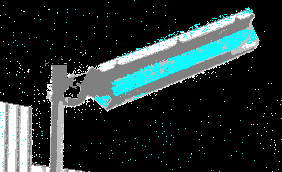 This is the tall tale and ultimately sad lament of the inspirational, sparkling, bold, forward looking Westinghouse Whiteways. These sleek fluorescent tubed street lights embodied the high minded 1950s optimism and prosperity, that ushered in with a touch of white gloved class the new bright future that the post war years promised, at least for two long beleaguered New York City thoroughfares that had only just emerged from decades in the dank, rank shadows of decrepit and stultifying elevated railway structures. This is the tall tale and ultimately sad lament of the inspirational, sparkling, bold, forward looking Westinghouse Whiteways. These sleek fluorescent tubed street lights embodied the high minded 1950s optimism and prosperity, that ushered in with a touch of white gloved class the new bright future that the post war years promised, at least for two long beleaguered New York City thoroughfares that had only just emerged from decades in the dank, rank shadows of decrepit and stultifying elevated railway structures. |
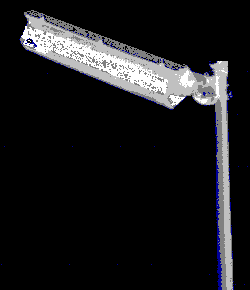 In 1955, dark, dank and cavernous 3rd Avenue (the Manhattan
section anyway), was rescued from the shadows of the ancient
elevated transit line that had rumbled over it since 1871. 3rd
Avenue emerged into the sunlight for the first time in 84 years,
but had much recuperating to do. The long dark decades had left
it an infested slum, for virtually its entire stretch of nearly
200 blocks. It didn't take long for this prime piece of real
estate to stage one of the most glorious comebacks of any road
on earth. One symbol of it's rising granduer were it's shining,
new, fluorescent streetlights.
In 1955, dark, dank and cavernous 3rd Avenue (the Manhattan
section anyway), was rescued from the shadows of the ancient
elevated transit line that had rumbled over it since 1871. 3rd
Avenue emerged into the sunlight for the first time in 84 years,
but had much recuperating to do. The long dark decades had left
it an infested slum, for virtually its entire stretch of nearly
200 blocks. It didn't take long for this prime piece of real
estate to stage one of the most glorious comebacks of any road
on earth. One symbol of it's rising granduer were it's shining,
new, fluorescent streetlights. |
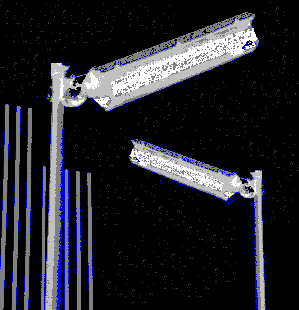 They were a celebration of the avenue's new freedom, from
the yoke of the old el. These bright, blazing fluorescent fixtures
didn't cower at the corners, like the meek little Bishop crook
cast iron poles did. They boldly declared, "THIS IS 3RD
AVENUE, BABY! DIG IT!". They pointed straight into the sky
and 3rd Avenue's architecture soon followed their lead. Today,
much of 3rd Avenue, from midtown, through the upper east side,
is a breathtaking canyon of high rise buildings. They were a celebration of the avenue's new freedom, from
the yoke of the old el. These bright, blazing fluorescent fixtures
didn't cower at the corners, like the meek little Bishop crook
cast iron poles did. They boldly declared, "THIS IS 3RD
AVENUE, BABY! DIG IT!". They pointed straight into the sky
and 3rd Avenue's architecture soon followed their lead. Today,
much of 3rd Avenue, from midtown, through the upper east side,
is a breathtaking canyon of high rise buildings. |
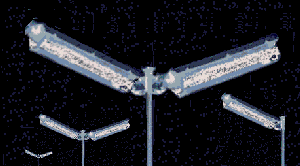 In the mid 50's, these fixtures must've looked awesome, to
a city still dominated, by little incandescent cup, bell &
gumball lights. Like Detroit's post war cars and 3rd Avenue's
new buildings, they were bigger and better. They made 3rd Avenue
special, made it sparkle and certainly were the Royalty of Roadlighting
in NYC, through the 60's.
In the mid 50's, these fixtures must've looked awesome, to
a city still dominated, by little incandescent cup, bell &
gumball lights. Like Detroit's post war cars and 3rd Avenue's
new buildings, they were bigger and better. They made 3rd Avenue
special, made it sparkle and certainly were the Royalty of Roadlighting
in NYC, through the 60's. |
| The city also installed them on 9th Avenue, in rundown Hells
Kitchen and Chelsea. I suppose the city had hopes of inspiring
a renaissance on that west side thoroughfare. Like 3rd, 9th Avenue
had also emerged from the killing shadows of a grimy el, just
before World War II. There would be no rebound for 9th.
Unfortunately, the proud, erect fluorescent tubes couldn't perform more than one miracle. On 9th Avenue, they looked toward the sky, not to inspire their surroundings, but to avoid seeing them. They also failed to have any appreciable effect on lower 3rd Avenue, The Bowery, which remained a skid row and, if such a thing was possible, even declined further as a neighborhood. They stood their ground as the Bowery wound its way through Chinatown, into Chatham Square. |
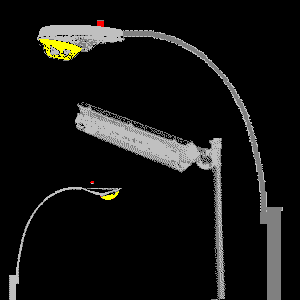 These mighty symbols of New York City's post war prosperity followed
the whole course of the old 3rd Avenue el, down to the Park Row-Brooklyn
Bridge- City Hall plaza. Perhaps a fickle city blamed these heroic
luminaires for the failures of continuing slums, like 9th Avenue
and the Bowery, overlooking their electrifying effect on upper
3rd. Heroes are often hung out to dry here. The Whiteways had always held their own in a city dominated by their mercury vapor contemporaries, the Westinghouse and GE cobra heads, who never made a move to dislodge them. These mighty symbols of New York City's post war prosperity followed
the whole course of the old 3rd Avenue el, down to the Park Row-Brooklyn
Bridge- City Hall plaza. Perhaps a fickle city blamed these heroic
luminaires for the failures of continuing slums, like 9th Avenue
and the Bowery, overlooking their electrifying effect on upper
3rd. Heroes are often hung out to dry here. The Whiteways had always held their own in a city dominated by their mercury vapor contemporaries, the Westinghouse and GE cobra heads, who never made a move to dislodge them.
In the 1970's however, the ballgame changed cruelly on the Whiteways. The mercury vapor era proved short lived and street light technology was marching on, spurred by an ever rising crime rate that had frightened citizens clammering for more effective, wider spread illumination at night. As befell their cobra head siblings, the fellow Westinghouse Silverliners and arch rival GE M400s, the Whiteways found themselves upended by the new luminaire terrors, the "Doubtful" looking GE M400A2 Power Doors and the Thomas Betts TB-327 "Dummies", both sodium vapor cobra heads that teamed up with the infamous uplift mast arms made famous by Kojak street footage, the "Quarterloops". Together they teamed up to eradicate the abandoned and demoralized 3rd Avenue and Bowery Whiteway tubes, which by then were hanging perilously to their poles on badly rusting hinges. |
| The Whiteways put up more of a fight on slummy 9th Avenue. Perhaps
they developed a streetfighters attitude, having spent over 20
years on that mean street. Nonetheless, they did not survive long
into the 80's there. Park Row was their last stand, and the same
merciless reconstruction of the Brooklyn Bridge approaches, that
saw the wholesale massacre of so many "Cheerful" Silverliners and Whitestone poles, also claimed the last
of these. The "Bigger" that the Whiteways represented, was
no longer considered "Better". The policies that allowed
the grandeur of 3rd Avenue and big, bright, juice-hungry fixtures,
was no longer in vogue. Small was in, with little gnat-like, low-cost
luminaires. One last refuge for the Tubes may be in North Bergen,
New Jersey, where I believe they still grace one of that town's
main avenues. An early visitor and data contributor to this site, Larry Rojak shared some heretofore absent info on the Whiteways: "I lament the passing of the Third Avenue Fluorescent. I well remember the Park Row group. The last one I ever saw was on the corner of 3d Avenue around 86th Street in the mid 1980s. Those fixtures were made by Westinghouse; I have an advertising brochure from 1960 that called them "Whiteway" lights because they were meant to provide super-bright lighting for downtown shopping areas. They sported six high-output fluorescents." |
Originally written in 1996. Some statements of what still survive may no longer apply as this was updated in 2018.
